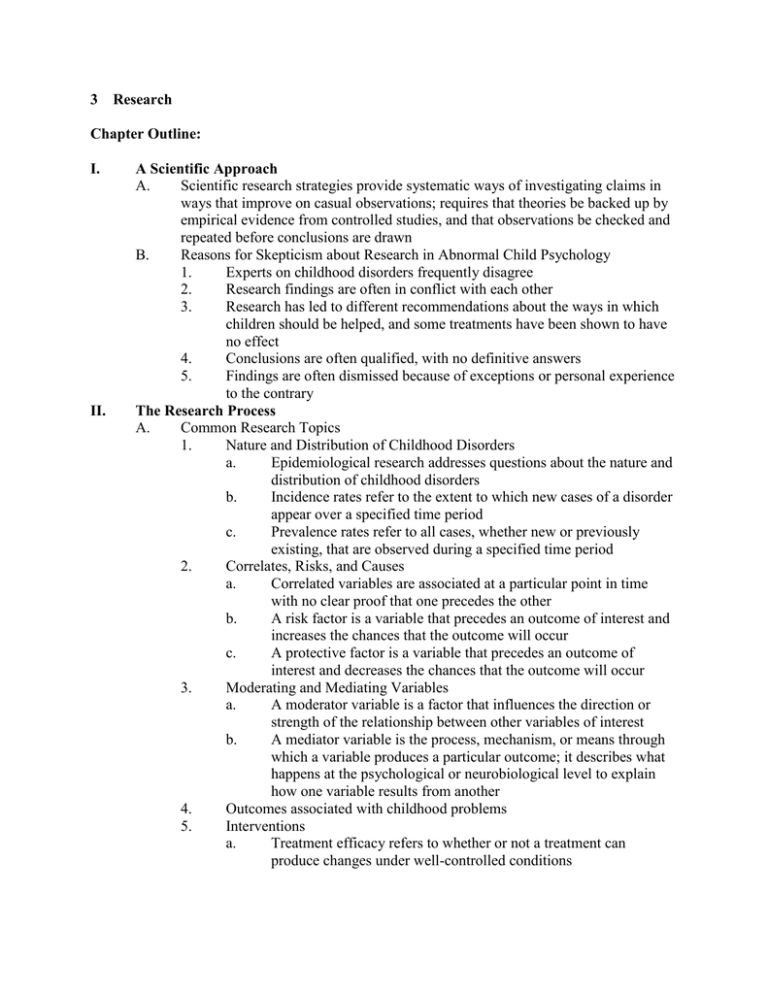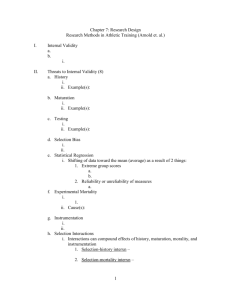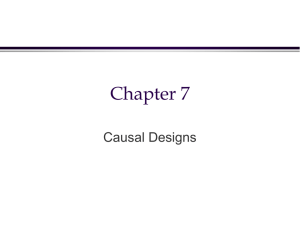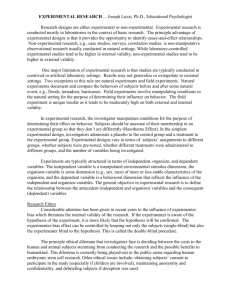3 Research Chapter Outline: I.
advertisement

3 Research Chapter Outline: I. II. A Scientific Approach A. Scientific research strategies provide systematic ways of investigating claims in ways that improve on casual observations; requires that theories be backed up by empirical evidence from controlled studies, and that observations be checked and repeated before conclusions are drawn B. Reasons for Skepticism about Research in Abnormal Child Psychology 1. Experts on childhood disorders frequently disagree 2. Research findings are often in conflict with each other 3. Research has led to different recommendations about the ways in which children should be helped, and some treatments have been shown to have no effect 4. Conclusions are often qualified, with no definitive answers 5. Findings are often dismissed because of exceptions or personal experience to the contrary The Research Process A. Common Research Topics 1. Nature and Distribution of Childhood Disorders a. Epidemiological research addresses questions about the nature and distribution of childhood disorders b. Incidence rates refer to the extent to which new cases of a disorder appear over a specified time period c. Prevalence rates refer to all cases, whether new or previously existing, that are observed during a specified time period 2. Correlates, Risks, and Causes a. Correlated variables are associated at a particular point in time with no clear proof that one precedes the other b. A risk factor is a variable that precedes an outcome of interest and increases the chances that the outcome will occur c. A protective factor is a variable that precedes an outcome of interest and decreases the chances that the outcome will occur 3. Moderating and Mediating Variables a. A moderator variable is a factor that influences the direction or strength of the relationship between other variables of interest b. A mediator variable is the process, mechanism, or means through which a variable produces a particular outcome; it describes what happens at the psychological or neurobiological level to explain how one variable results from another 4. Outcomes associated with childhood problems 5. Interventions a. Treatment efficacy refers to whether or not a treatment can produce changes under well-controlled conditions b. III. Treatment effectiveness refers to whether the treatment can be shown to work in actual clinical practice rather than in wellcontrolled laboratory conditions Methods of Studying Behavior A. Standardization, Reliability, and Validity 1. Standardization is the process by which a set of norms is specified for a measurement procedure so that it can be used consistently across different assessments of the construct of interest 2. Reliability refers to the consistency of measures, either across raters or time; it is essential for validity 3. Validity is the extent to which a method actually measures the construct of interest; it may be examined with respect to the measure’s content, correlation with similar and unrelated measures, predictive ability, and whether scores agree with what would be predicted by existing theory and past research B. Measurement 1. Reporting a. Reporting methods include unstructured clinical interviews, highly structured interviews, and questionnaires b. Inaccuracies may occur because of inability to recall events, selective recall or bias, and intentional distortions c. Requires a certain level of verbal ability, therefore not reliable with children under age 7 or 8 2. Psychophysiology and Neuroimaging a. Most common physiological responses recorded are measures of autonomic nervous system activity, such as heart rate, blood pressure, respiration, pupil dilation, and electrical conductance of the skin b. Limitations of physiological measures include inconsistency across studies, high level of inference about why there are physiological differences, and the role of extraneous influences c. Electroencephalogram (EEG) measures electrical activity of the brain; different EEG waves may suggest sleep disturbances or various emotional states d. Neuroimaging procedures examine the structure and/or function of the brain; structural-imaging procedures include magnetic resonance imaging (MRI) and coaxial tomographic (CT) scan, whereas functional-imaging techniques include positron emission tomography (PET) and functional magnetic resonance imaging (fMRI) 3. Observation a. May range from unstructured, naturalistic observations in the child’s environment to highly structured observations in a clinic or laboratory b. Structured observations are cost-effective, allow for focused attention on the phenomena of interest, are useful for studying c. IV. infrequent child behaviors, and allow for greater control over the situation than do naturalistic observations A major drawback of observational methods is that one cannot be sure if the observations are a representative sample of the behavior of interest. In the presence of an observer, children and parents may not behave as they normally would Research Strategies A. Validity of Studies 1. Internal validity reflects the extent to which a particular variable, rather than extraneous influences, accounts for the results, changes, or group differences; internal validity may be threatened by maturation, the effects of testing, and subject selection biases 2. External validity reflects the extent to which findings can be generalized to people, settings, times, measures, and characteristics other than the ones in a particular study; external validity may be threatened by characteristics and reactivity of the subjects participating in the research, the research setting, and the time at which measurements are made B. Identifying the Sample 1. A careful definition of the sample is critical for comparability of findings across studies 2. Possible comorbidities among the sample must also be considered 3. Random selection is rare in child psychopathology studies; often need to use a sample of convenience C. General Approaches 1. Nonexperimental and Experimental Research a. True experiments are those in which researchers have maximum control over independent variables, subjects are randomly assigned to groups, and possible sources of bias are controlled (not typical in research in child psychopathology) b. Correlational studies allow researchers to examine relationships among variables; a correlation coefficient describes the degree of association between two variables; does not imply causality c. Random assignment of participants to treatment groups increases the chance that other characteristics other than the independent variable will be equally distributed across treatment groups d. Natural experiments involve comparisons between conditions that already exist; these are essentially correlational studies, but subjects are selected to ensure that their characteristics are as comparable as possible with the exception of the independent variable (common in child psychopathology research) 2. Prospective and Retrospective Research a. In retrospective designs, a sample is identified and asked for information relating to an earlier time period; retrospective designs are highly susceptible to recall bias and distortion b. D. In real-time prospective designs, the sample is identified and followed longitudinally over time; prospective designs are time consuming and subject to loss of participants over time 3. Analogue Research - Evaluates a specific variable of interest under conditions that only resemble or approximate the situation to which one wishes to generalize; purpose is often to examine a specific process that would otherwise be difficult to study Research Designs 1. Case Studies a. Involve intensive and usually anecdotal observations and analyses of an individual child b. Rich sources of descriptive information; provide basis for developing and trying treatment techniques c. Drawbacks include uncontrolled methods and selective biases, as well as the inherent difficulties associated with integrating observations, drawing valid inferences among variables, and generalizing from one child to other children 2. Single-Case Experimental Designs a. Used frequently to evaluate the impact of clinical treatments b. Involve repeated assessment of behavior over time, the replication of treatment effects within the same subject, and the subject serving as his or her own control c. Two common examples are the A-B-A-B (reversal) design and the multiple-baseline design across behaviors, situations, or individuals d. Advantages include personal quality of the case study and objective evaluation of alternative and combined forms of treatment e. Weaknesses include the possibility of interactions between treatments and subject characteristics, limited generality of findings, and subjectivity and inconsistency of visual inspection of the data 3. Between-Group Comparisons Designs - Involve comparisons between experimental and control groups; differences between groups can be attributed to the experimental condition 4. Cross-Sectional Studies a. Individuals at different ages or stages of development are studied at the same point in time b. Although efficient and less susceptible to attrition and practice effects, they do not allow for inferences about change in the individual and are susceptible to cohort effects 5. Longitudinal Studies a. The same individuals are studied at different ages or stages of development b. Populations of interest are often children who are at risk for developmental problems due to a risk factor; allows for V. identification of patterns that are common to all children and for tracking differences in developmental paths c. Disadvantages include time commitment, increased costs, aging effects, cohort effects, period effects, and practice effects E. Qualitative Research 1. Focuses on narrative accounts, description, interpretation, context, and meaning; purpose is to describe, interpret, and understand the phenomenon of interest in the context in which it is experienced 2. Although intensive and intimate, may be biased by the researcher’s values and preferences, and findings cannot be generalized to other individuals Ethical and Pragmatic Issues A. Informed Consent and Assent 1. Informed consent involves fully informing participants of the nature of the research, risks, benefits, expected outcomes, and alternatives, as well as giving the option to withdraw from the study; parents need to give consent for children 2. Assent (meaning that the child shows some form of agreement to participate without necessarily understanding the full significance of the research) must be obtained when the child is around the age of 7 or older 3. When research is carried out in institutions (such as schools, day cares, or medical settings) consent must also be obtained from individuals appointed to act on children’s behalf B. Voluntary Participation 1. Participation in research must be voluntary 2. May be compromised by subtle pressure and coercion 3. Volunteerism may itself be a biasing factor in research C. Confidentiality and Anonymity 1. Disclosed information must be kept confidential; individuals must be advised about any exceptions to confidentiality 2. Confidentiality may become problematic when a child or parent reveals past abuse or the possibility of future abuse D. Nonharmful Procedures - No research procedures may be used that may harm a child physically or psychologically E. Other Ethical and Pragmatic Concerns - May arise when research involves potentially invasive procedures, deception, the use of punishment, and/or the use of incentives; final responsibility of the ethical integrity is with the investigator




